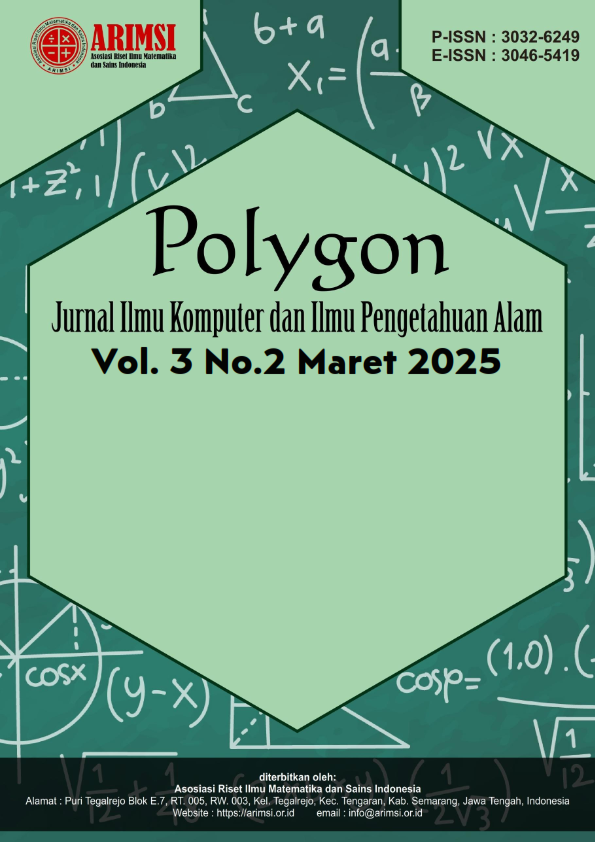Analisis Faktor Risiko Yang Berkontribusi Terhadap Kejadian Tuberkulosis Paru di Masyarakat
Studi Epidemiologis Dan Implikasinya Dalam Pencegahan
DOI:
https://doi.org/10.62383/polygon.v3i2.451Keywords:
Tuberculosis, case distribution, informal workers, risk factors, public healthAbstract
Tuberculosis (TB) remains one of the main challenges in the health sector in Indonesia, with a fairly high number of cases each year. This study aims to analyze the distribution of TB cases based on occupation and identify community groups that are at higher risk of spreading this disease. The data used in this study were obtained from estimates of the 2022 TB epidemiology report. The results of the analysis show that informal workers, such as laborers and traders, are the group with the highest number of TB cases, at 36.0%. This is followed by formal workers (21.6%), farmers/fishermen (17.3%), housewives (14.4%), students (6.5%), and unemployed or retired groups (4.2%). The high prevalence of TB in informal workers is caused by several factors, including an unhygienic work environment, limited access to health services, and unhealthy lifestyles. Based on these findings, a more effective strategy is needed in efforts to prevent and control TB, especially for groups with high levels of vulnerability. Health education, increasing access to health services, improving work environment sanitation, and early detection programs are important steps in reducing the spread of TB. With the right intervention, it is hoped that the number of TB cases in Indonesia can be reduced significantly.
Downloads
References
Amalia, R. B., Wahyuni, I., & Ekawati. (2017). Hubungan antara karakteristik individu, beban kerja mental, pengembangan karir, dan hubungan interpersonal dengan stres kerja pada guru di SLB Negeri Semarang. Jurnal Kesehatan Masyarakat, 5(5), 2356-3346.
Darmin, Akbar, H., & Rusdianto. (2020). Faktor yang berhubungan dengan kejadian tu-berkulosis paru di wilayah kerja Puskesmas Inobonto Factors. Media Publikasi Promosi Kesehatan Indonesia The, 3(3), 223–228.
Hidayat, R., Bahar, H., & Ismail, C. S. (2017). Skrining dan studi epidemiologi penyakit tuberkulosis paru di Lembaga Pemasyarakatan Kelas II A Kendari tahun 2017. Jurnal Ilmiah Mahasiswa Kesehatan Masyarakat, 2(6), 250-731X.
Kenedyanti, E., & Sulistyorini, L. (2017). Analisis Mycobacterium tuberculosis dan kondisi fisik rumah dengan kejadian tuberkulosis paru. Jurnal Berkala Epidemiologi, 5(2), 152–162.
Mariana, D., & Chairani, M. (2017). Kepadatan hunian, ventilasi, dan pencahayaan ter-hadap kejadian TB paru di wilayah kerja Puskesmas Binanga Kabupaten Mamuju Sulawesi Barat. Poltekkes Kemenkes Mamuju, 3(2), 2528-5602.
Nugroho, H. P., Cicih, L. H. M., & Hastono, S. P. (2021). Analisis kondisi fisik rumah dan karakteristik responden terhadap kejadian tuberkulosis di Kecamatan Ciledug Kota Tangerang. Jurnal Ilmiah Analis Kesehatan, 7(1), 98–110.
Oktavia, S., Mutahar, R., & Destriatania, S. (2016). Analisis faktor risiko kejadian TB paru di wilayah kerja Puskesmas Kertapati Palembang. Jurnal Ilmu Kesehatan Masyarakat, 7(2), 124–138.
Pertiwi, R. N., Wuryanto, M. A., & Sutiningsih, D. (2012). Hubungan antara karakteristik individu, praktik hygiene dan sanitasi lingkungan dengan kejadian tuberkulosis di Kecamatan Semarang Utara tahun 2011. Jurnal Kesehatan Masyarakat, 1(1), 435–445.
Sari, R. P., & Arisandi, R. D. (2018). Faktor-faktor yang berhubungan dengan kejadian penyakit TB paru di wilayah kerja Puskesmas Walantaka. Jurnal Ilmu Kesehatan Masyarakat, 7(1), 25–32.
Tirtana, B. T. (2011). Faktor-faktor yang mempengaruhi keberhasilan pengobatan pada pasien tuberkulosis paru dengan resistensi obat tuberkulosis di wilayah Jawa Ten-gah. Fakultas Kedokteran Undip. Semarang.
Downloads
Published
How to Cite
Issue
Section
License
Copyright (c) 2025 Polygon : Jurnal Ilmu Komputer dan Ilmu Pengetahuan Alam

This work is licensed under a Creative Commons Attribution-ShareAlike 4.0 International License.





